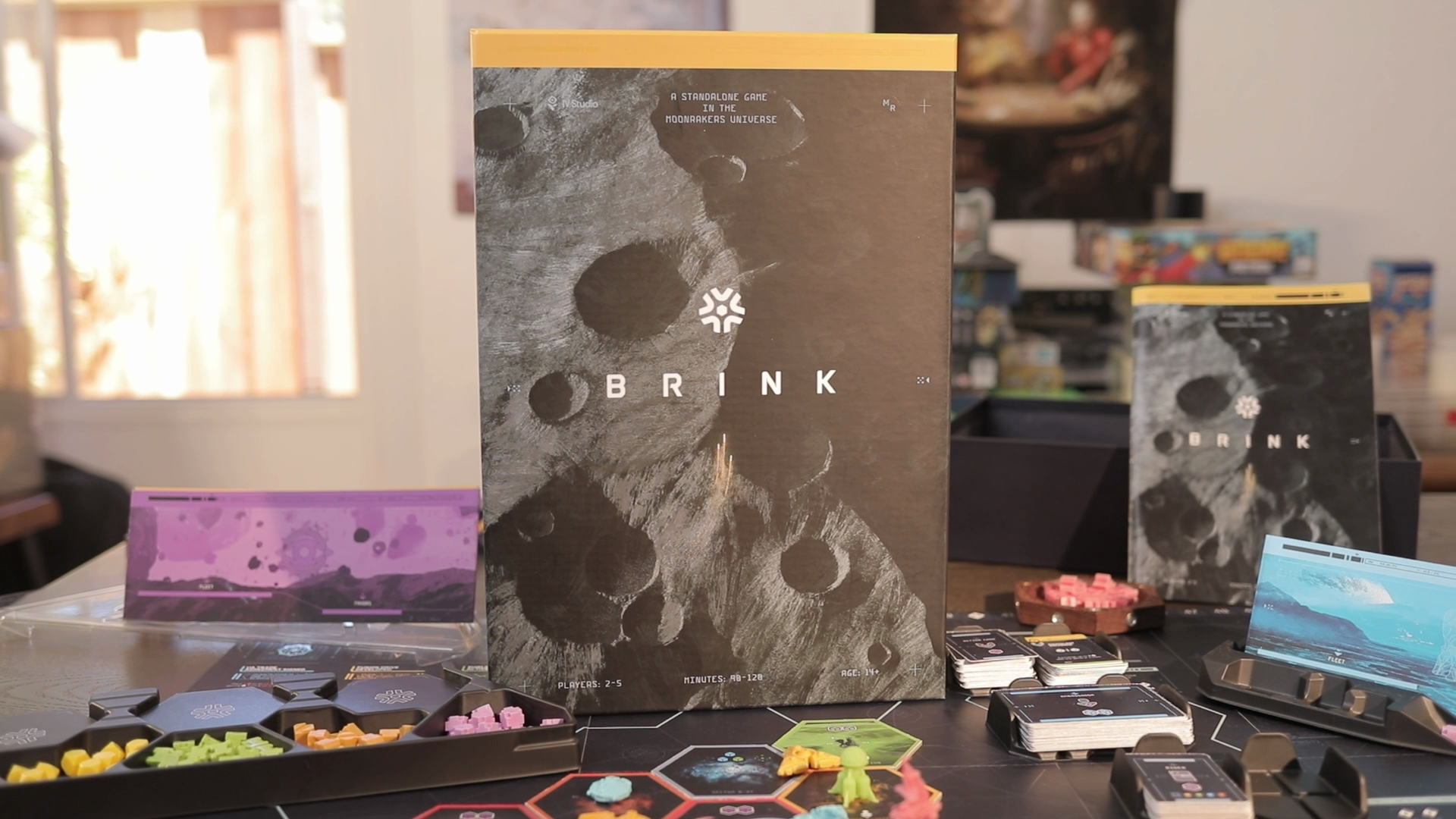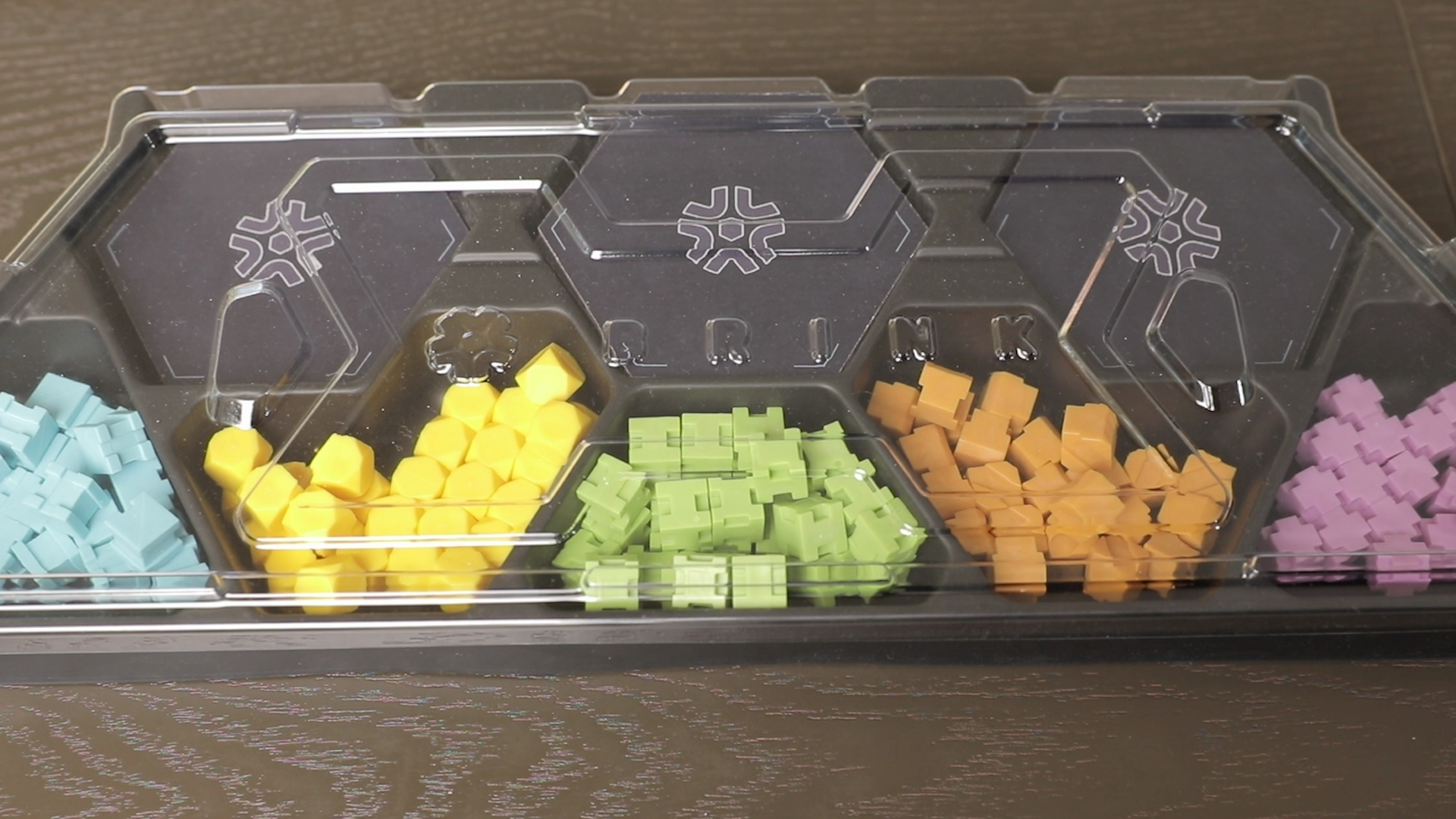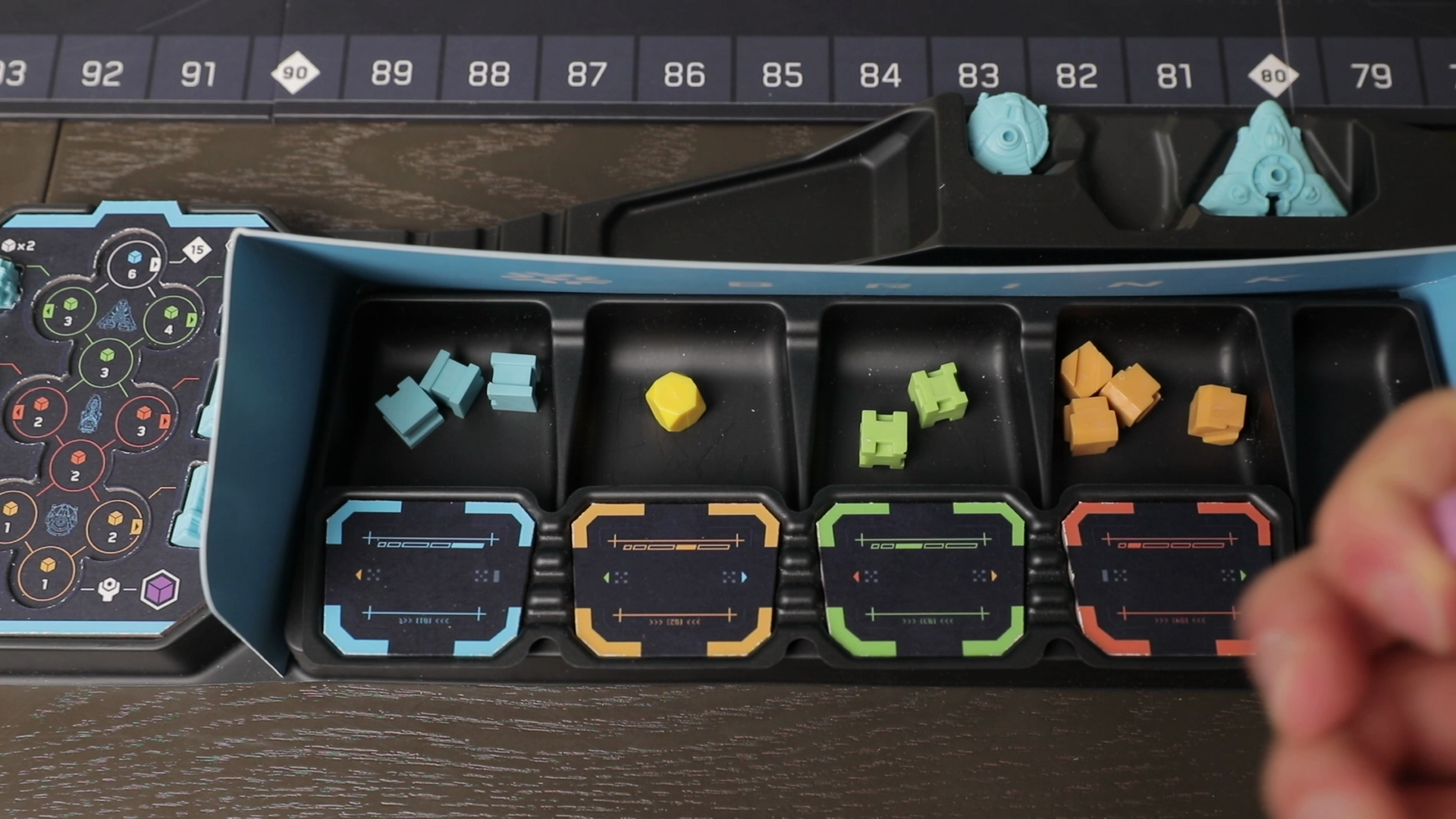Brink Prototype Review
Part area-control, part worker placement, and part trading frenzy, IV Studio’s biggest game is certainly bold.
A worker placement-ish game, combined with constant trading and a climatic end of round vote! Your ships double as workers to help gather cubes and assert power over colors to later vote on. Negotiate your way through 3 rounds for 2-5 players, 90-120 minutes.
Video published July 2nd, 2024
This is a sponsored post. Prototype featured.
Our Plays
1x 3P
1x 4P
Frog counters you see are not part of the game :)
Need to learn how to play? Or want more reasoning for our points? Our review video’s got you!
Component Pros
Player tray holds cubes, ships, upgrades, and player screen
Even assists in putting upgrades/ships away
Mini upgrades have own place to slot in
3 ship minis are distinct feeling to reflect their scope
Upgrades slot in well
5 different cube colors all have own cutout and are great to touch
Fits in own tray with a plastic lid
No plastic bags needed to put away game
Card trays for all decks of cards
Card tray to fit faction objectives, with minis/hex slotting in at the top
Very consistent sci-fi futuristic look
Some glossy areas of the board
Cards have cool styling on them
IP address (probably fake) on rulebook and player aid margins
Gameplay Pros — Fun twist on Worker Placement
3 different workers with scaling strength and influence to make placement sequencing tricky
Place big ship early to get a lot now, or save it for later?
Collecting is complex because give cubes AND actions AND give a color for end of round
e.g. Want to make sure collecting enough cubes this round to activate the “upgrade action” you place on
Gameplay Pros — Cube Economy
Dynamic markets with Revolt Mechanic (when 1 color hits 0, everyone discards half of that color)
Give players agency on everyone’s cube stashes
Easy to do, upgraded ship can easily take half of the supply
Discarding half of other’s cubes not only hurts them but gives you an idea of how many cubes they have left
Strongly discourages hoarding cubes unless you can make sure the supply is full or can ensure others don’t place on that color
Sometimes discourages trading for opponent’s temporary cubes because you want them to be wasted to refill the supply
Don’t want to trade for something then immediately have to discard it off a revolt
Cubes have shifting point value
If you buy faction objectives, they’re 1 point per cube for that player
If cube wins 1st/2nd twice, each cube is 1x for everyone
If wins 1st/2nd 3x, each cube is 2x for everyone
Cubes “winning” end of round vote means they -1 in quantity to mark how many cubes are left
Action cards can be substituted for cubes on your turn for more trade-off thinking
Gameplay Pros — End of Round Vote has nuance and differentiation between rounds
Riders: Up to 4 of them can be placed during a round to really influence how voting will go
e.g. If a color does not place (1st or 2nd), trigger a revolt in that color
e.g. all purples cast for this color are now +1 in voting strength
e.g. everyone gets rewarded for scoring a color if it gets 2nd place
Mind games on how many votes 1 door will get
Purple is wildcard to be any color and 2x value
Possible for someone to dump ALL purples into 1 color
Have to think about each player’s desires to get colors 1st/2nd, then you vote as little as possible to save cubes
Post-vote there are ambassador/action card abilities to manipulate vote
e.g. ambassador to spend a cube and dump 3 more cubes inside
e.g. action cards to +3 or -2 vote last minute
Culminates in making voting phase tense as each player is pushing it towards their own direction, and they’re all invested since it’s main way to get points
Progression Pros
Map increases for more options from exploring, usually 2.5-3x the starting map
Ships getting stronger is satisfying
2x their power (points from hex color winning a vote next to them)
2x their income (quite ridiculous on the strongest ship to get a flood of cubes)
Faction objectives bought about mid-game
e.g. Can add purple (wild) next to the board
e.g. Shield lattice to boost an area +1 power
e.g. UA flagship to -1 an area power
e.g. Fusion Drive to make 2nd tier ship movable by spending a yellow cube
Now everyone else can spend 3 yellow to move theirs (yellow cubes now have new usage)
Cube management gets more nuanced as game goes on from previous pros
Replayability Pros
Dozen unique Ambassador cards to experiment with
e.g. Using colors as different colors
e.g. Get to move your small ship at small fee
e.g. Rewarded by taking other action
Rider cards have some pairs but lots of uniques
Can be any color you’d like
Making map as you play means tons of different permutations
Component Cons
Prototype rulebook has some confusing things, but will likely get fixed
Some rough prototype visual woes
Red looks pink for cubes
Yellow cube income on hexes looks orange
Orange faction looks like the yellow hex
Having yellow and orange used in such close proximity in a game is likely not the best idea, maybe swap our 1 player color for white
Text is ridiculously small everywhere
Faction objective board text (that gets unlocked when objective bought) is impossible to read unless sitting very closely to it
FIX: A card handed out to everyone the moment the objective is bought
Player screen feels like wasted opportunity to ways to get points and explain other areas
Player colors are exact same as other non-player components in game which is confusing
Maybe make player colors 2-tone, or change shade
If colorblind game is likely difficult to navigate
Gameplay Cons — Exploring
Cannot plan around new exploration flips at all
Vastly different: some give more resources, some don’t give actions, some are worth 2x power, some worth 0 power
Can feel really bad in early game to explore something that is awful fit
Worst case scenario: Use big ship and get 2 upgrade actions you can’t use
Late game can randomly flip exploration tiles that fit the game state, i.e. riders all benefit 1 color and you flip it
Randomness via exploring is fine, just needs to be mitigated
e.g. 4x’s have limited exploration, and lots of time to fight against someone who jumps ahead
e.g. Takenoko, when you add a hex, you draw 3 tiles, then pick 1, then don’t even have to perform that hex
Exploring also clashes with worker placement, since if someone blocks you, you can always just explore
Maybe you’ll get something better, the same, or worse. Not sure what to expect
Perhaps reduction in blocking is to reduce analysis paralysis, but we confirmed with designers that blocking wasn’t their focus
Blocking IS a big draw of worker placement to many though
Exploration FIX: Take it out of the game and have preset maps that everyone has full knowledge to plan for, slowly gets unlocked at start of every round
Gameplay Cons — Faction Objective Balance
UA Trade Agreement is underpowered
Gets you -8 vote potential via red cubes, which is fine, but bottom adds -2 cubes to board for anyone to get (so not necessarily a plus for you)
Compare to “Construct Shield Lattice” that costs the same, and gets you many additional points end game from having more power
AND you can move the shield lattice with infinite range every round!
UA Trade Agreement -8 votes feels underpowered 4P+ with more players
Then make the red tokens dropped on the board only attainable by you
Gameplay Cons — Riders
Only have 1 in hand, so if you don’t like the 1 in hand, you HAVE to play the one you draw which feels bad
Although you do get to choose the color so it doesn’t feel as bad
Riders in general are just swingy and only the person putting it down gets to influence
e.g. Tersima Enhancement to have action cards now worth +2 towards that color
e.g. 1 color that I happen to have a lot of are now treated as ANY color for voting, now I get to swing immensely
Players closer to starting player want to play riders to have influence over direction of voting, try to fill up the rider column (4 cards)
Whoever goes last in round can just freely react to those riders
If initial players don’t play riders, going last can just play riders that benefit themselves
FIX: Riders are not card in hand, rather 4 of them are flipped over from deck at the start of round
Then can see each of them, then when go to rider space, you pay a purple cube to add cube onto one of them
Gameplay Con — Some Minor Trading Irks
About half of the resource gathering of trade has to be traded by end of turn, so you MUST unload and feels bad
Trading on almost every single turn adds time length to game
Hard to negotiate someone not to go somewhere, because they can just explore
Don’t know what anyone else’s upgrade costs are, since every player has different ones, so can unintentionally feed them
Put everyone’s upgrade costs in your player screen?
Trading is not “bad”, with lots of trading interest and big trades happening before voting sometimes
Player Count Cons
3P is the way to play compared to 4P
Only 3 rounds, in 4p it feels bad if don’t get to go last
There used to be a 4 round mode that got taken out
3P has less actions amongst players before it gets back to you, so less likely rider slot will get filled with something you don’t like
Tentative Score: 6/10 Above Average
Component wise, Brink looks and feels pretty cool, minus the visual prototype jank, and its gameplay is pretty cool too… it has a lot of cool ideas its exploring but maybe it needs more massaging for its final form. Different ships that double as workers and ways to secure area control, cubes that have constant changing value where you’re constantly trading them, and a dynamic vote to wrap up every round. There’s more cool- you can upgrade your ships, you get cool abilities via riders or ambassador abilities or faction objectives! You can even explore the map! For technically infinite types of maps… but is it even worth the hits to gameplay for infinite amounts of maps?
When we look at the whole package, of all this different cool- Brink doesn’t really excel at any one category… yet. It’s not really that good of a worker placement because it’s not trying to have blocking in it with exploration… in fact exploration isn’t a good fit with it also suddenly giving you new areas to have some area control-ish potential right before a vote happens.. So then Brink’s focusing on a really tense vote- which it does well… if not modified by unfair feeling rider cards. It’s cool, but flawed.
Also, with so much randomness with cards and exploration baked in for about 2 hours… this is actually just a fairly casual game, despite all of the abilities and cube dynamics. Like, there’s action cards that can give people actions even if you tried to block those actions on the board, but again blocking isn’t the intention of this worker placement-ish game. So again, Brink is gonna appeal to a more lax crowd that is really likes the theme and table trading, and is still ok with more things to read, are ok with the smaller text.
Brink is about the looks on your opponents faces when you revolt and screw them hard, or abusing a rider to make their color suddenly get 2nd place, and heck that’s a ton of player interaction! But it’s likely a little too intense for someone looking for the next step after say, just knowing Catan… but if you played a lot of board games and LOVE Catan for constantly trading the cube market can appeal to you.
But I will point out that, currently, going last in the final round is REALLY good, and you need to play around it well- one good counterplay is making sure that person doesn’t get the shield lattice faction objective. But if the target audience is to play more casually, is this something the group will be focused on? But then I heard the way IV Studios might determine first player is via a space on the board! This would DRASTICALLY change the game for sure.
Oh yeah, we didn’t talk about time length- our games ran a bit long, at about 3 hours each for both 3 and 4p, but I definitely suspect those time lengths could go down a little with experience. I’m not faulting Brink too much for this, as it does say 90-120 minutes, but a lot of the time does get eaten up by the trading you’re doing on most turns. But you may want to consider if someone AP’s the heck out in deciding where to place workers, because man there’s a LOT of areas each of your different workers can go…
Also we don’t know much about the 2P variant, where you can play a “rival”, but we didn’t think play testing such a player interactive game with a robot was very helpful for the scope of this review, but hey you DO get to influence it by trading with it, and there’s less rider interference because less players. So this could be decent!
And, if the 3 major gameplay cons we listed in cons were smoothed out, we could see this be a 7/10 recommender. But for right now, we can only play this 6/10 prototype.
































